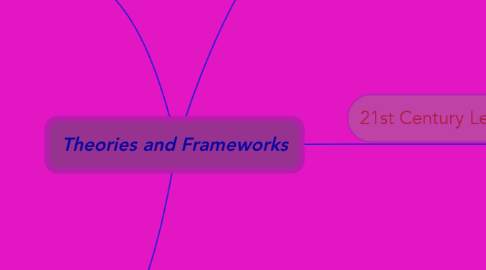
1. SAMR
1.1. Transformation
1.1.1. Modification
1.1.1.1. Technology allows for significant redesign
1.1.2. Redefinition
1.1.2.1. Technology allows for the creation of new tasks, previously inconceivable.
1.2. Enhancement
1.2.1. Augmentation
1.2.1.1. Technology acts as a direct tool substitute, with functional improvement.
1.2.2. Substitution
1.2.2.1. Technology acts as a direct tool substitute, with no functional change
1.3. SAMR is an approach to see how technology can change teaching and learning in the classroom
2. TPACK
2.1. Educators must possess 3 primary types of knowledge
2.1.1. Technology(TK)
2.1.2. Pedagogy(PK)
2.1.3. Content(CK)
2.2. These 3 areas of knowledge also intersect with each other creating 4 more combined types of knowledge
2.2.1. Pedagogical content knowledge(PCK)
2.2.2. Technological pedagogical knowledge(TPK)
2.2.3. Technological content knowledge(TCK)
2.2.4. Technological Pedagogical Content Knowledge (TPACK)
2.3. Every teacher has their own unique way of applying the TPACK framework in their classroom
2.4. Click the arrow for a look at the TPACK venn diagram
3. Philosophy of Teachnology
3.1. Concerns the way educators use technology to teach.
3.2. Every teacher has their approach too using technology in their classroom
3.2.1. Idea 1
3.2.1.1. Sub Idea 1
3.2.1.2. Sub Idea 2
3.2.2. Idea 2
3.2.3. Idea 3
3.2.4. Idea 4
3.2.5. Plan
3.2.5.1. Goals
3.2.5.1.1. Goal 1
3.2.5.1.2. Goal 2
3.2.5.2. Rules
3.2.5.2.1. Session Rule 1
3.2.5.2.2. Session Rule 2
3.2.5.3. Define Problems
3.2.5.4. Capture Ideas
3.2.5.5. Prioritize Ideas
3.2.5.6. Define Action Points
3.3. When using technology in the classroom there are 4 basic principles to keep in mind.
3.3.1. Alignment
3.3.1.1. Must relate to classroom material and serve a purpose to teaching
3.3.2. Accesibility
3.3.2.1. Students are easily able to access the technology you are using
3.3.3. Assessment
3.3.3.1. Be clear on how your students will be graded when using technology
3.3.4. Reinforcement
3.3.4.1. When using technology to restructure a lesson, it shouldn't be a replica of the non-technological format you used for that lesson.
4. 21st Century Learner
4.1. Foundational KNowledge
4.1.1. Content
4.1.2. Information literacy
4.1.3. Cross-disciplinary knowledge
4.2. Meta Knowledge
4.2.1. Problem solving
4.2.2. communication/collaboration
4.2.3. Creativity
4.3. Humanistic knowledge
4.3.1. Life/Job skills
4.3.2. cultural competance
